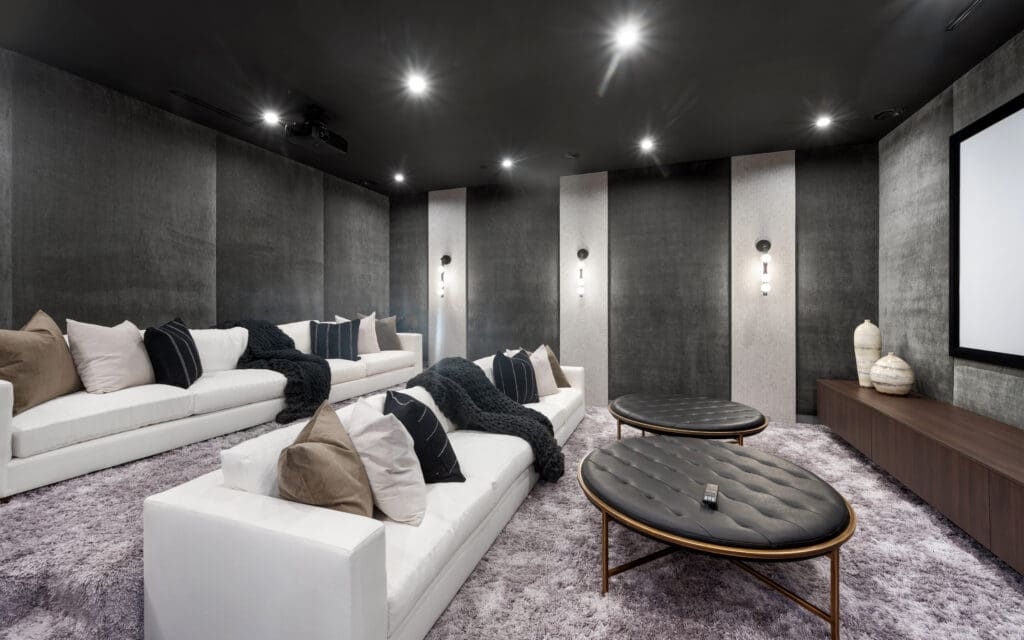Key Highlights
- Experience Cinematic Thrills: Transform your house into an immersive home theater and enjoy the magic of cinema without leaving your couch.
- Strategic Planning: Choosing the right room and understanding basic acoustics are very important for an optimal home theater setup.
- Selecting the Perfect Gear: Explore options in screens, projectors versus TVs, and sound systems to fit your budget and preferences.
- Design & Ambiance: From seating arrangements to lighting, each element contributes to an authentic movie theater experience.
- Seamless Installation: Follow our step-by-step audio and video setup guides for a hassle-free installation.
- Smart Enhancements: Elevate your home theater with smart home integration and personalized touches for an unforgettable experience.
Introduction
Are you passionate about movies and crave that immersive movie theater experience in the comfort of your own home? Setting up a home theater system might seem like a daunting task, but with this guide, it doesn’t have to be. Using the right combination of audio equipment, screen, and design elements, you can transform any room into a haven for cinematic enjoyment. Get ready to experience movies like never before with powerful surround sound, crystal-clear visuals, and an ambiance tailor-made for movie nights.
Planning Your Home Theater System
Before rushing into buying expensive equipment, it’s crucial to plan your home theater system meticulously. Begin by defining your budget and understanding your needs. Are you a casual movie viewer, or do you demand the ultimate cinematic experience? This will help to narrow down your options and ensure that your investment aligns with your home theater aspirations.
A well-planned home theater is more than just a room with a large screen. Factors like room size, shape, and ambient light can influence audio and visual quality. Consider whether you’ll be renovating an existing space or starting from scratch. Don’t forget to factor in the cost of wiring, installation, and any acoustic treatments that might be needed for optimal sound quality.
Determining the Best Room for Your Home Theater
The first step to creating your home theater is choosing the right space. Converting a spare bedroom or finishing your basement are excellent starting points. Remember that a dedicated theater room offers more control over lighting and acoustics, which is essential for recreating that authentic movie theater experience.
Think about the size of the room in relation to the large screen you desire. Ideally, the back row of seating should be a comfortable distance away from the screen. Consider the room’s layout and whether it can accommodate all of your desired seating arrangements without feeling cramped.
Another critical aspect is the room’s acoustic properties. Too much echo or sound reflection can negatively impact your audio experience. Take note of hard surfaces like windows, walls, and floors, which can cause sound reflections. Addressing these early on with acoustic treatments or strategic furniture placement can make a huge difference.
Understanding the Basics of Home Theater Acoustics
You can have the most high-end audio equipment, but without proper acoustics, your sound quality will suffer. Understanding how sound behaves in your theater room can drastically enhance your viewing experience. Sound waves reflect off hard surfaces, creating echoes and distortion.
Consider incorporating acoustic panels in your home theater design. These specialized panels are designed to absorb sound waves, reducing reflections and creating a more balanced and immersive surround sound experience, particularly noticeable in action-packed movies.
Don’t underestimate the impact of soft furnishings either. Thick carpets, curtains, and even strategically placed furniture can all play a part in absorbing excess sound and improving the overall acoustic quality of your home theater.
Selecting Your Home Theater Equipment

Now comes the exciting part: choosing your equipment. The market is flooded with options, so knowing your needs and budget is essential. Invest in quality over quantity, focusing on components that will deliver the best movie-watching experience.
Consider factors like screen size, resolution, sound system compatibility (Dolby Atmos, anyone?), and any additional features like smart home integration. Don’t be afraid to listen to your ears and trust your eyes, researching reviews and comparisons to select the best equipment for your home theater.
Choosing the Right Screen: Projector vs. TV
When it comes to screens, the battle between projectors and TVs is a classic one. While both can offer stunning visuals, understanding their strengths is crucial. Projectors offer that classic movie theater large screen experience and deliver excellent HD resolution, making them ideal for dedicated home theaters. However, they require more space and careful light control for optimal viewing.
TVs, on the other hand, are brighter, easier to set up, and work well in rooms with ambient light. While they might not provide the same massive screen size as a projector, modern TVs come in larger sizes and resolutions, some even rivaling the immersive experience of projectors.
Here’s a quick breakdown:
Projector:
- Pros: Large screen size, cinematic experience, good for dedicated theater rooms.
- Cons: Susceptible to ambient light, requires more setup and calibration.
TV:
- Pros: Brighter image, easier setup, works well in rooms with ambient light.
- Cons: Limited screen size compared to projectors.
Deciding on a Sound System: Surround Sound vs. Soundbar
Next up, the heart of your home theater: the sound system. Your options generally boil down to a surround sound system or a soundbar. Surround sound systems, especially those with Dolby Atmos capability, deliver unmatched sound quality and positional audio, placing you right in the heart of the action. However, they require multiple speakers, a receiver, and can be more complex to set up.
Soundbars offer a simpler solution with impressive sound quality and a smaller footprint. While they might not achieve the same level of immersion as a dedicated surround sound system, they are a great option for smaller rooms or those looking for an easier installation process.
Let’s break it down:
Surround Sound:
- Pros: Unmatched sound quality, immersive Dolby Atmos experience, ideal for dedicated home theaters.
- Cons: Requires multiple speakers and a receiver, more complex installation.
Soundbar:
- Pros: Simpler setup, space-saving design, good sound quality for smaller rooms.
- Con: Might not match the immersive experience of surround sound.
Designing the Home Theater Space

With your equipment selected, it’s time to create the ambiance. Think about the overall aesthetic you’re going for. Should it evoke a classic movie theater or a more modern, minimalist vibe? Color palettes, lighting, and furniture all play a crucial role in shaping the mood and enhancing that cinematic experience.
Consider dark, matte colors for the walls and ceiling to minimize light reflections and create a more immersive environment. Add dimmable lights to set the mood, and don’t forget comfortable seating where you can relax and enjoy hours of cinematic adventures.
Seating Arrangements for Optimal Viewing
Just like in a movie theater, seating arrangement in your home theater plays a major role in how much you enjoy your favorite movies. The goal is to ensure everyone has an unobstructed view of the screen and is comfortably positioned for optimal sound quality.
If you’re opting for multiple rows, consider a tiered platform for the back rows to avoid heads blocking the view. Plush, reclining seats with cup holders are always a popular choice, replicating that authentic movie theater experience.
Don’t forget to account for traffic flow and spacing. Ensure there’s enough room to move around comfortably, especially if you have snacks and drinks on hand during movie nights.
Lighting Considerations for Enhancing Your Viewing Experience
Lighting can make or break your movie theater experience. Avoid bright overhead lights, as they create glare on the screen and disrupt the cinematic ambiance. Instead, opt for dimmable lights that can be adjusted to create the perfect mood for movie watching.
Wall sconces are an excellent addition, providing soft, ambient light that doesn’t interfere with the screen. You can also use LED strip lighting behind the screen to create a subtle backlight, enhancing contrast and reducing eye strain during those extended movie marathons.
Consider installing blackout curtains or blinds to eliminate any external light sources leaking into your home theater. This ensures optimal picture quality, especially for projectors, and adds to the cozy, immersive atmosphere you’re aiming for.
Installation Essentials
With the planning and design phases completed, it’s time for installation. While some might prefer professional help, setting up your home theater yourself can be a rewarding experience. Plus, it gives you complete control over the process and saves you money.
Arm yourself with the right tools, carefully follow the manufacturer’s instructions, and don’t hesitate to consult online resources or tutorials. Patience and attention to detail are key to a successful and rewarding installation.
Step-by-Step Guide to Audio Setup
Setting up your audio system might seem daunting, but it’s fairly straightforward when broken down into steps. Start by connecting your audio sources like your Blu-ray player, gaming console, or streaming devices to the receiver using HDMI cables for optimal audio and video signals.
Connect your speakers to the appropriate channels on the receiver, ensuring proper left, right, center, and surround sound placement. Run speaker wires through the walls or ceiling for a clean and organized look. If needed, use banana plugs for easier connections.
Once everything is connected, run the receiver’s auto-calibration feature if available. This will optimize the sound output for your specific room dimensions and speaker placement. Experiment with different sound settings to achieve the audio balance that best suits your preferences.
Video Setup Tips for a Crisp Picture
Whether you’ve chosen a projector or a TV, a crisp, clear image is essential for an optimal viewing experience. Connect your video source (Blu-ray player, streaming device, etc.) to your projector or TV using a high-quality HDMI cable to ensure you’re getting the best possible signal for your HD content.
If using a projector, adjust the focus, zoom, and keystone settings to ensure the image fills the screen properly and is free from distortion. Consider using a projector screen with a gain rating appropriate for your room’s ambient light conditions to enhance picture quality.
For TVs, adjust the picture settings, including brightness, contrast, and sharpness, to achieve the best possible image quality for your room. Experiment with different picture modes (Cinema, Game, etc.) depending on your viewing content.
Enhancing Your Home Theater Experience

While a functional home theater is great, adding those extra touches can elevate your movie nights to the next level. Consider incorporating cool gadgets that enhance convenience or take your home theater to the next level of sophistication.
Think universal remotes for effortless control, a popcorn machine for that authentic movie-theater feel, or even a mini-fridge for easy access to refreshments. These small additions contribute a great deal to creating unforgettable movie experiences.
Smart Home Integration for Easy Control
In today’s connected world, why settle for anything less than a smart home theater? Integrating your home theater with a smart home system like Amazon Alexa or Google Assistant unlocks new possibilities and seamless control. Imagine dimming the lights, starting the movie, and adjusting the volume all with simple voice commands.
Connect your compatible devices to your home’s Wi-Fi to control your home theater system through a dedicated app on your smartphone or tablet. This allows you to conveniently manage various functions, from adjusting sound settings to browsing for your favorite movies without leaving your seat.
Consider incorporating smart lighting solutions to automate your lighting scenes. Create personalized settings for “movie time” that automatically dim the lights to the perfect level, creating a more immersive movie-watching experience.
Adding Personal Touches to Your Home Theater
While functionality is vital, don’t underestimate the power of personalization. Adding your unique style and decorative flourishes makes the space feel more inviting and reflects your passion for cinema.
Start with the decor. Consider movie posters of your favorite films, framed vintage movie tickets, or even a red carpet runner for a touch of Hollywood glamour. Comfortable throws and cushions enhance the cozy factor, making those extended movie marathons even more enjoyable.
Don’t be afraid to get creative with your home theater design. Display your favorite movie memorabilia, incorporate themed lighting, or create a snack bar area stocked with your favorite treats for an extra special touch.
Transform Your Home Today!
Transforming your living space into a home theater oasis is an exciting journey. By understanding the acoustics, selecting the right equipment, and designing the perfect setup, you can create a cinematic experience right at home. Remember, optimal viewing angles, immersive sound systems, and cozy seating arrangements are key.
Enhance your experience with smart home integration for seamless control and personal touches to make it uniquely yours. Now, sit back, relax, and immerse yourself in the world of entertainment within the comfort of your own home.
For expert guidance on setting up your dream home theater system, get in touch with us today.
Frequently Asked Questions
What is the Ideal Size for a Home Theater Screen?
The ideal home theater screen size depends on the distance between the screen and the back wall or the last row of seating. A general rule is that the screen should occupy about 40 degrees of your field of vision for a comfortable and immersive movie theater experience.




